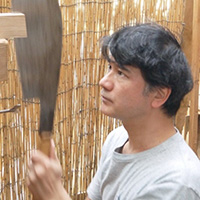Takao Morita
- Wood and Bamboo
-
Price Range
$1,000 - 7,000
Info
The prices of the artworks on Gallery Japan are determined by the artists themselves and are published directly on the website.
close - Awards at Japan Kōgei Assoc. Exhibitions : 2
Purchase artwork, commission work, check artworks available for purchase, etc.
- CategoryWood and Bamboo
-
TechniquesHollow work
-
Born1973 -
-
MembershipResearch member, Japan Kogei Association

Style
Mainly producing kurimono (hollowed woodworks) and sashimono (wood joinery).
Kurimono is made by hollowing a block of wood with a chisel, mini plane, or carving knife etc. to freely shape and carve out vessels and boxes.
Sashimono is a traditional technique to assemble wooden items without nails, using basic joinery techniques called hagite, hashibami, tome and kumite. Various things from large furniture such as desks and shelves, to small boxes can be made using these techniques. The wood base is made using these techniques and is finished with wipe lacquer. By adding other traditional techniques, the piece can become a folk artwork.
Soetsu Yanagi, the first advocator of the Mingei (Folk Art) Movement, discovered the beauty of artwork from the Korean Joseon Dynasty. The delicate, well-balanced and exquisite Joseon Dynasty furniture and the elegance of the Imperial culture in Kyoto have something in common. It was natural for woodwork artist Tatsuaki Kuroda who admired and worshipped the Joseon Dynasty culture, to recreate and enhance the Korean art into a Japanese style artwork. It is also convincing that Kuroda's artwork was loved in Korea.
Hida Takayama is located in a valley beyond deeply forested mountains. Time flows slowly in this area as if we've time slipped to the past. From its townscape it is called "Little Kyoto". In this town is the "Yoshijima Family House" designated as an important cultural property of Japan. The central pillar of the house is lacquered with brownish black lacquer, and the lacquered beams and short pillars create a cubic lattice in the center of the house. Inside the house is a Japanese-style chest, an origin of Japanese furniture. I visited this place to learn about Japanese woodwork. It is an important place for me as a woodworker, and I try to merge what I've seen and learned with my original ideas to create my artwork. I think this how I create my original style.
There is an old saying that says, "All rivers aim at flowing into the sea and flow into the sea in the end", meaning that people can also accomplish great things if we learn from admirable people and work hard to reach one's own goal. In Buddhism, it is said that the amount of training we must go through to accomplish spiritual enlightenment is enormous. Like the Tripiṭaka master who traveled to India to receive the Buddhist Scripture in "Journey to the West", I am always trying to make my best artwork while thinking what woodwork is about. The techniques to make woodwork are intangible, but I want to express things that cannot be described with words in my artwork for people to see.
Biography
-
1973Born in Izumisano City, Osaka
-
1994Graduated from Naniwa Junior College (current Osaka University of Arts Junior College), Design Art Department, Plastic Arts major
-
1996Graduated from Gifu Prefectural Takayama Technical College, Woodwork Department (current Gifu Prefectural Woodwork School)
Learned woodwork and wipe lacquering techniques from woodwork artist in Kyoto -
1998Selected for the 27th Kinki Traditional Kōgei Exhibition for the first time
Selected for the 8th Wood and Bamboo Traditional Kōgei Exhibition for the first time -
1999Selected for the 14th Fugaku Biennale for the first time
Negoro Lacquerware Study Group / Lacquerware Research and Development Center Artwork Exhibition (Industrial Technology Center of Wakayama Prefecture) -
2002Selected for the 48th All Kansai Exhibition for the first time
Masterpieces of the East and West Art Exhibition (Daimaru Shinsaibashi Store) -
2009CRIA Exhibition
-
2013First Solo Exhibition at Kintetsu Department Store, Abeno
-
2018Completed extension courses at Osaka University
Art planning seminar / ”The Memory Theater II"
Awards
-
2001Received the Osaka Prefectural Board of Education Award at the 7th Shinbi Kogei Association Exhibition
-
2003Received the Shinbi Kogei Association Incentive Award at the 9th Shinbi Kogei Association Exhibition
-
2005Received the Shinbi Kogei Association Grand Award at the 11th Shinbi Kogei Association Exhibition
Received the New Artist Incentive Award at the 34th Kinki Traditional Kōgei Exhibition -
2007Received the Shinbi Kogei Association Incentive Award at the 13th Shinbi Kogei Association Exhibition
Received the Konosuke Matsushita Memorial Award at the 36th Kinki Traditional Kōgei Exhibition -
2009Received the Osaka Prefectural Board of Education Award at the 15th Shinbi Kogei Association Exhibition
-
2010Received the Shinbi Kogei Association Award at the 16th Shinbi Kogei Association Exhibition
-
2012Received the Yomiuri Shimbun Osaka Head Office Award at the 18th Shinbi Kogei Association Exhibition
-
2014Received the Shinbi Kogei Association Incentive Award at the 20th Shinbi Kogei Association Exhibition
